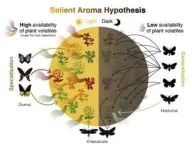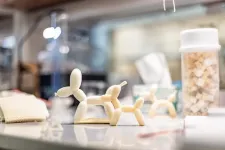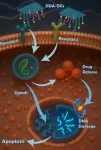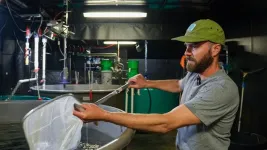(Press-News.org) UNIVERSITY PARK, Pa. — The scent of blooming flowers and fresh plant life is not just a perk of springtime; it is a key driver in the survival and evolution of butterflies and moths. New research led by scientists at Penn State reveals how the daily cycles of plant aromas are linked to the dietary habits and evolution of the winged insects collectively known as Lepidoptera.
In a recent study published in the journal Proceedings of the Royal Society B, an international team of researchers tested a new hypothesis for why some Lepidoptera have very specific diets, feeding on only a few types of plants, while others are far less picky.
The new idea, called the Salient Aroma Hypothesis, suggests that the smells plants release play a crucial role in determining how specialized a butterfly or moth's diet becomes. The researchers found that greater availability of plant aromas during the day provides more chemical information for day-active insects to use to locate and specialize on particular host plants, while the decrease in plant aromas at nighttime means night-active Lepidoptera have to take what they can get and have a more varied diet.
“This idea provides a new perspective on why some butterflies and moths are picky eaters while others are not,” said Po-An Lin, an assistant professor at the National Taiwan University who launched the research while earning his doctoral degree from Penn State and continued the work as a postdoc in Taiwan. “It also highlights the critical role of plant volatiles, or scents, in shaping insect-plant interactions and evolutionary adaptations.”
To determine whether plant scent may have driven adaptation, the researchers looked at the insects’ primary organs for smelling — the antennae — and compared the antennal size of 582 specimens from 94 species of butterflies and moths.
The Penn State team collaborated with a team at Harvard that found that female Lepidoptera that are active during the day tend to have larger antennae relative to their body size than those active at night.
This might suggest that having better "smelling" equipment is more beneficial when there are more smells to detect, explained Gary Felton, the Ralph O. Mumma Professor of Entomology at Penn State, co-author on the paper and Lin’s research adviser. Similarly, specialist female Lepidoptera — those that feed from only a few types of plants — often have larger antennae than generalist females, possibly because they need to be very good at detecting the specific aromas of their host plants.
“The relationship between antennal size and host plant breadth was very strong,” Felton said. “Larger antennal sizes have been associated with a greater number of sensilla, the sensory structures involved in the sense of smell, thereby increasing the surface area for sensory receptors. The enhanced capacity may be a key adaptation for how certain Lepidoptera have evolved to feed on a limited and specific range of plants."
The findings suggest a potential link between the availability of plant aromas during the day and an evolutionary investment in olfactory structures in the insects, particularly in females that engage in host plant selection by laying their eggs on the plant, Lin explained.
“This finding demonstrates how the availability of chemical signals influences the evolution of sensory organs in insects,” he said. “It provides a fascinating example of how plants, through their chemical emissions, have played a direct role in shaping the evolution of the insects that rely on them.”
Lin and colleagues at Penn State used a combination of approaches to investigate the link between plant aromas and Lepidoptera diets. They first conducted a meta-analysis of existing scientific literature to confirm that plants generally release more diverse and abundant volatile organic compounds, or aromas, during the day versus the night. Then they studied the Lepidoptera family tree to analyze the relationship between the insects' activity patterns — day or night active — and their preferred host plants, using statistical models that account for evolutionary relationships.
“Our analyses showed a significant correlation between being active during the day or night and the diversity of host plant species that Lepidoptera consume,” said Naomi Pierce, professor of biology at Harvard University and co-author on the paper.
The researchers found that day-active Lepidoptera, like monarch butterflies, have more opportunities and more specialized organs to detect plant aromas and, as such, have evolved to be picky eaters. On the other hand, night-active species, like the Polyphemus Moth, encounter fewer and less diverse plant aromas. With less clear chemical information available, it might be harder for them to be so selective, potentially leading them to have more generalized diets, feeding on a wider range of plants.
“Insect herbivores, such as butterflies and moths, must find the right plants to feed on and, in the case of females, to lay their eggs,” Lin said. “This is a crucial decision because caterpillars depend entirely on the selected plant for survival. Unlike humans, who eat a wide variety of foods to stay healthy, many insect herbivores specialize in feeding on only a few plant species. The Salient Aroma Hypothesis helps explain why some insects are highly specialized while others are more flexible in their diet.”
The other authors on the paper are Wei-Ping Chan and Even Dankowicz of Harvard University; Liming Cai of the University of Texas Austin; Yun Hsiao of National Taiwan University; and Kadeem Gilbert of Michigan State University.
The U.S. National Science Foundation, Taiwan’s National Science and Technology Council and the Yushan Fellowship Program from the Ministry of Education of Taiwan funded this work.
END
Picky eaters by day, buffet by night: Butterfly, moth diets sync to plant aromas
Plant scent cycles shape diets and antennae size of pollinators, new research shows
2025-04-03
ELSE PRESS RELEASES FROM THIS DATE:
Pennington Biomedical’s Dr. Leanne Redman honored with the E. V. McCollum Award from the American Society for Nutrition
2025-04-03
The American Society for Nutrition, or ASN, and the ASN Foundation announced the distinguished recipients of the 2025 National Scientific Achievement Awards today. Recognizing outstanding contributions and pioneering advancements in the field of nutrition, these awards serve as a testament to excellence and innovation. Among the honorees is Pennington Biomedical Research Center’s Dr. Leanne Redman, who received the E. V. McCollum Award – given to a clinical investigator who is perceived as a major creative force, actively generating new concepts in nutrition and personally seeing to the execution of studies testing the validity of these concepts.
Dr. Redman is associate ...
CCNY physicists uncover electronic interactions mediated via spin waves
2025-04-03
Groundbreaking research by physicists at The City College of New York is being credited for a novel discovery regarding the interaction of electronic excitations via spin waves. The finding by the Laboratory for Nano and Micro Photonics (LaNMP) team headed by physicist Vinod Menon could open the door to future technologies and advanced applications such as optical modulators, all-optical logic gates, and quantum transducers. The work is reported in the journal Nature Materials.
The researchers showed the emergence of interaction between electronic excitations (excitons – electron hole pairs) mediated via spin waves in atomically thin (2D) magnets. They demonstrated ...
Researchers’ 3D-printing formula may transform future of foam
2025-04-03
From seat cushions to mattresses to insulation, foam is everywhere — even if we don’t always see it.
Now, researchers at The University of Texas at Dallas have fused chemistry with technology to create a 3D-printed foam that is more durable and more recyclable than the polymer foam found in many everyday products.
The research, which appears in the March 1 print edition of RSC Applied Polymers, a journal of the Royal Society of Chemistry, focused on creating a sturdy but lightweight foam that could be 3D-printed, a method that is still largely unexplored in commercial manufacturing, said the study’s co-lead author, UT Dallas doctoral student Rebecca Johnson ...
Nurture more important than nature for robotic hand
2025-04-03
How does a robotic arm or a prosthetic hand learn a complex task like grasping and rotating a ball? The challenge for the human, prosthetic or robotic hand has always been to correctly learn to control the fingers to exert forces on an object. The sensitive skin and nerve endings that cover our hands have been attributed with helping us learn and adapt our manipulation, so roboticists have insisted on incorporating sensors on robotic hands. But–given that you can still learn to handle objects with gloves on– there must be something else at play.
This mystery is what inspired researchers in the ValeroLab in the Viterbi School of Engineering ...
Drug-delivering aptamers target leukemia stem cells for one-two knockout punch
2025-04-03
CHAMPAIGN, Ill. — Drug-carrying DNA aptamers can deliver a one-two punch to leukemia by precisely targeting the elusive cancer stem cells that seed cancer relapses, researchers at the University of Illinois Urbana-Champaign report.
The aptamers — short single-strand snippets of DNA that can target molecules like larger antibodies do — not only deliver cancer-fighting drugs, but also are themselves toxic to the cancer stem cells, the researchers said.
Led by Xing Wang, a U. of I. professor of bioengineering and of chemistry, the researchers documented their findings in the journal Advanced Functional Materials.
“This ...
New study finds that over 95% of sponsored influencer posts on Twitter were not disclosed
2025-04-03
New INFORMS journal Marketing Science Article Key Takeaways:
Over 95% of sponsored influencer posts on Twitter were not disclosed.
Influencer sponsorship arrangements with younger brands are less likely to be disclosed.
A large number of consumers can’t detect the sponsorship arrangement without disclosure.
The consumer-protection regulatory environment around undisclosed sponsorships has lagged behind.
BALTIMORE, MD, April 3, 2025 – New research in the peer-reviewed journal Marketing Science has found that 95% of influencer posts on Twitter (now X), which are sponsored, are not disclosed.
The ...
New sea grant report helps great lakes fish farmers navigate aquaculture regulations
2025-04-03
DULUTH, Minn.–Fish farmers across the Great Lakes states can face a confusing web of permits, policies and regulations that can hinder the growth of their operations. A new Sea Grant publication, Aquaculture Regulations in the Great Lakes, offers much-needed clarity.
The report breaks down complex legal frameworks and provides practical insights to help aquaculture producers understand and navigate state and regional requirements with greater confidence. It was developed by the National Sea Grant Law Center (NSGLC) ...
Strain “trick” improves perovskite solar cells’ efficiency
2025-04-03
Solar energy is one of the most promising solutions for reducing our dependence on fossil fuels. But making solar panels more efficient is a constant challenge. Perovskite solar cells (PSCs) have been a game-changer, offering rapid improvements in efficiency and potential for low-cost manufacturing. However, they still suffer from energy losses and operational stability issues.
The challenge with wide-bandgap perovskites
Perovskite solar cells, particularly those used in tandem configurations, rely on wide-bandgap (WBG) materials—semiconductors that absorb higher-energy ("bluer") ...
How GPS helps older drivers stay on the roads
2025-04-03
How GPS helps older drivers stay on the roads
Peer reviewed – observational study - humans
Sat Nav systems help keep older drivers on the roads for longer, according to new research from the University of East Anglia.
A new study published today reveals that over 65s with a poorer sense of direction rely more on help from GPS navigation systems such as Sat Nav or smartphone maps.
Those using GPS tended to drive more frequently - suggesting that the technology helps older people maintain driving independence.
Senior author Prof Michael Hornberger, from UEA’s Norwich Medical School, said: “Driving is usually the preferred mode of transport among ...
Estrogen and progesterone stimulate the body to make opioids
2025-04-03
Scientists have discovered a new mechanism that acts via an immune cell and points toward a different way of treating chronic pain.
Female hormones can suppress pain by making immune cells near the spinal cord produce opioids, a new study from researchers at UC San Francisco has found. This stops pain signals before they get to the brain.
The discovery could help with developing new treatments for chronic pain. It may also explain why some painkillers work better for women than men and why postmenopausal ...
LAST 30 PRESS RELEASES:
Manta rays create mobile ecosystems, study finds
Study: Mixed results in using lipoic acid to treat progressive multiple sclerosis
Norbert Holtkamp appointed director of Fermi National Accelerator Laboratory
New agentic AI platform accelerates advanced optics design
Biologists discover neurons use physical signals — not electricity — to stabilize communication
Researchers discover that a hormone can access the brain by hitchhiking
University of Oklahoma researcher awarded funding to pursue AI-powered material design
Exploring how the visual system recovers following injury
Support for parents with infants at pediatric check-ups leads to better reading and math skills in elementary school
Kids’ behavioral health is a growing share of family health costs
Day & night: Cancer disrupts the brain’s natural rhythm
COVID-19 vaccination significantly reduces risk to pregnant women and baby
The role of vaccination in maternal and perinatal outcomes associated with COVID-19 in pregnancy
Mayo Clinic smartwatch system helps parents shorten and defuse children's severe tantrums early
Behavioral health spending spikes to 40% of all children’s health expenditures, nearly doubling in a decade
Digital cognitive behavioral treatment for generalized anxiety disorder
Expenditures for pediatric behavioral health care over time and estimated family financial burden
Air conditioning in nursing homes and mortality during extreme heat
The Alps to lose a record number of glaciers in the next decade
What makes a good proton conductor?
New science reporting guide published for journalists in Bulgaria
New international study reveals major survival gaps among children with cancer
New science reporting guide published for journalists in Turkey
Scientists develop a smarter mRNA therapy that knows which cells to target
Neuroanatomy-informed brain–machine hybrid intelligence for robust acoustic target detection
Eight SwRI hydrogen projects funded by ENERGYWERX
The Lundquist Institute and its start-up company Vitalex Biosciences Announces Strategic Advancement of Second-Generation fungal Vaccine VXV-01 through Phase 1 Trials under $40 Million Competitive Con
Fine particles in pollution are associated with early signs of autoimmune disease
Review article | Towards a Global Ground-Based Earth Observatory (GGBEO): Leveraging existing systems and networks
Penn and UMich create world’s smallest programmable, autonomous robots
[Press-News.org] Picky eaters by day, buffet by night: Butterfly, moth diets sync to plant aromasPlant scent cycles shape diets and antennae size of pollinators, new research shows






